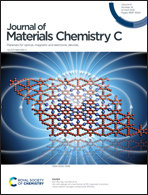Intense nonlinear dielectric and magnetic resonances of core–shell Ni@graphene composites and their improved microwave absorption properties†
Abstract
Rational design of the microstructure of carbon layers of the core–shell metal particle@graphene heterostructures offers immense potential for overcoming the challenges related to the microwave absorption performance. In this study, a new type of Ni@graphene microwave absorber with a controllable microstructure of graphene shells has been innovatively fabricated through an in situ transformation from a solid carbon precursor. The nonlinear dipole resonance of Ni/graphene interfaces induces an intense dielectric loss capacity, while the natural resonance is beneficial to a high magnetic loss. The composites comprising 30 wt% Ni@graphene particles in paraffin exhibit significantly improved absorption efficiency compared with pure Ni microspheres. Reflection loss (RL) values exceeding −10 dB are observed in the range of 15.28–15.6 GHz with a thickness between 2.0 mm and 5.0 mm, and an optimal RL value of −31.42 dB is obtained at 15.52 GHz with a matching thickness of 4.25 mm. More importantly, the maximum microwave absorption corresponding to the resonance frequency can be tuned by controlling the microstructure of graphene shells rather than changing the thickness of the absorbent. This opens up an effective strategy to synthesize attenuation materials with intrinsic narrowband resonance at microwave frequencies.



 Please wait while we load your content...
Please wait while we load your content...